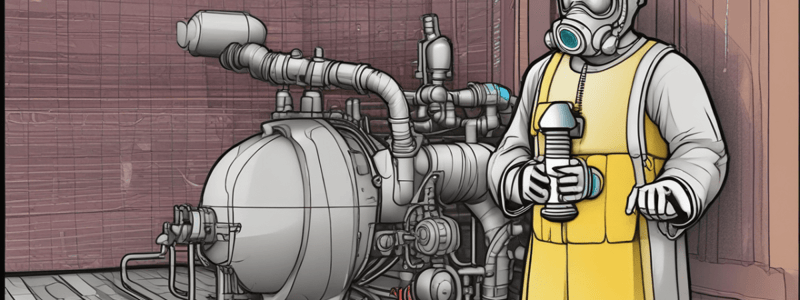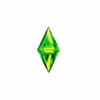Podcast
Questions and Answers
What is nitrous oxide commonly used as in the dental workplace?
What is nitrous oxide commonly used as in the dental workplace?
- An anesthetic agent (correct)
- A dental adhesive
- A disinfectant
- A sealing agent
What is a potential health effect of chronic exposure to nitrous oxide?
What is a potential health effect of chronic exposure to nitrous oxide?
- Respiratory problems
- Neurological abnormalities (correct)
- Cardiovascular issues
- Gastrointestinal problems
What is a measure that can be taken to prevent nitrous oxide leakage?
What is a measure that can be taken to prevent nitrous oxide leakage?
- Inspecting and maintaining the anesthetic delivery system (correct)
- Regularly cleaning the anesthetic delivery system
- Minimizing the use of nitrous oxide
- Using a scavenging system
What is a reported effect of cyanoacrylate toxicity in the dental workplace?
What is a reported effect of cyanoacrylate toxicity in the dental workplace?
What is a type of material that can emit volatile compounds that may cause irritative reactions?
What is a type of material that can emit volatile compounds that may cause irritative reactions?
What is the purpose of a scavenging system in the dental workplace?
What is the purpose of a scavenging system in the dental workplace?
What type of masks should be used when working with nitrous oxide?
What type of masks should be used when working with nitrous oxide?
What is cyanoacrylate commonly used as in the dental workplace?
What is cyanoacrylate commonly used as in the dental workplace?
What can be done to prevent sensorineural hearing loss?
What can be done to prevent sensorineural hearing loss?
What is a characteristic of ionizing radiation?
What is a characteristic of ionizing radiation?
What is a potential hazard to health associated with low levels of exposure to ionizing radiation?
What is a potential hazard to health associated with low levels of exposure to ionizing radiation?
What type of radiation is X ray an example of?
What type of radiation is X ray an example of?
What is a factor to consider when selecting dental equipment?
What is a factor to consider when selecting dental equipment?
What type of effect is caused by low levels of exposure to ionizing radiation?
What type of effect is caused by low levels of exposure to ionizing radiation?
What is the common symptom of musculoskeletal disorders in the fingers?
What is the common symptom of musculoskeletal disorders in the fingers?
What is the key to preventing work-related musculoskeletal disorders?
What is the key to preventing work-related musculoskeletal disorders?
What is the primary goal of ergonomics in dentistry?
What is the primary goal of ergonomics in dentistry?
What is the recommended design for instrument handles in dentistry?
What is the recommended design for instrument handles in dentistry?
What is the primary source of noise in dental clinics?
What is the primary source of noise in dental clinics?
What is the potential risk of hearing loss due to handpiece and ultrasonic scalers?
What is the potential risk of hearing loss due to handpiece and ultrasonic scalers?
At what decibel level can sustained exposure to handpiece and ultrasonic scalers result in sensorineural hearing loss?
At what decibel level can sustained exposure to handpiece and ultrasonic scalers result in sensorineural hearing loss?
What is the recommended adjustment for the dental chair to prevent musculoskeletal disorders?
What is the recommended adjustment for the dental chair to prevent musculoskeletal disorders?
What is an occupational hazard?
What is an occupational hazard?
What type of hazard is caused by infectious agents of human origin?
What type of hazard is caused by infectious agents of human origin?
How can a dentist become infected with a biological health hazard?
How can a dentist become infected with a biological health hazard?
What is an example of a physical hazard?
What is an example of a physical hazard?
What is a type of occupational hazard that affects the peripheral nervous system?
What is a type of occupational hazard that affects the peripheral nervous system?
How can a dentist prevent occupational hazards?
How can a dentist prevent occupational hazards?
What is an example of a chemical hazard?
What is an example of a chemical hazard?
What is a type of occupational hazard that can cause psychological distress?
What is a type of occupational hazard that can cause psychological distress?
What is a possible source of indirect infection in dentistry?
What is a possible source of indirect infection in dentistry?
Where can biological health hazards enter the body?
Where can biological health hazards enter the body?
What is a way to prevent biological health hazards?
What is a way to prevent biological health hazards?
What can happen to dental workers due to physical hazards?
What can happen to dental workers due to physical hazards?
What is a type of physical hazard in dentistry?
What is a type of physical hazard in dentistry?
What percentage of surgical procedures are associated with needlestick injuries?
What percentage of surgical procedures are associated with needlestick injuries?
What is a term that includes needlestick and sharp injuries?
What is a term that includes needlestick and sharp injuries?
What can result from needlestick injuries and cuts from sharp objects?
What can result from needlestick injuries and cuts from sharp objects?
What is a source of indirect infection in dentistry?
What is a source of indirect infection in dentistry?
What are the main entry points of infection in the body?
What are the main entry points of infection in the body?
What is a type of physical hazard in dentistry?
What is a type of physical hazard in dentistry?
What is a percutaneous exposure incident (PEI)?
What is a percutaneous exposure incident (PEI)?
What is a consequence of physical hazards in dentistry?
What is a consequence of physical hazards in dentistry?
What is a way to prevent biological health hazards in dentistry?
What is a way to prevent biological health hazards in dentistry?
What percentage of surgical procedures are associated with needlestick injuries?
What percentage of surgical procedures are associated with needlestick injuries?
What can result from needlestick injuries and cuts from sharp objects?
What can result from needlestick injuries and cuts from sharp objects?
What is a biological health hazard?
What is a biological health hazard?
How can a dentist become infected with a biological health hazard?
How can a dentist become infected with a biological health hazard?
What is an example of a physical hazard?
What is an example of a physical hazard?
What type of occupational hazard affects the peripheral nervous system?
What type of occupational hazard affects the peripheral nervous system?
What is a type of occupational hazard that can cause psychological distress?
What is a type of occupational hazard that can cause psychological distress?
Where can biological health hazards enter the body?
Where can biological health hazards enter the body?
What can happen to dental workers due to physical hazards?
What can happen to dental workers due to physical hazards?
What is a type of physical hazard in dentistry?
What is a type of physical hazard in dentistry?
What is the primary method of transmission of bloodborne infections between patients and healthcare workers?
What is the primary method of transmission of bloodborne infections between patients and healthcare workers?
How many needlestick injuries occur each year in the United States?
How many needlestick injuries occur each year in the United States?
What is a recommended prevention method for needlestick injuries?
What is a recommended prevention method for needlestick injuries?
What should be done immediately after a needlestick injury?
What should be done immediately after a needlestick injury?
What type of physical hazard can cause eye injury in dentistry?
What type of physical hazard can cause eye injury in dentistry?
What is a post-accidental management step after a needlestick injury?
What is a post-accidental management step after a needlestick injury?
What is a common source of physical hazards in dentistry?
What is a common source of physical hazards in dentistry?
What is the purpose of disposing of needles and sharp instruments in a sharp safe box?
What is the purpose of disposing of needles and sharp instruments in a sharp safe box?
Flashcards are hidden until you start studying
Study Notes
Chemical Hazards
- Nitrous oxide (N₂O) is used as an anesthetic agent, but chronic exposure is associated with neurological abnormalities and reproductive derangements (infertility).
- Transient irritative reactions of the eyes and airways have been observed, mostly associated with exposure to volatiles from resin-based materials, X-ray chemicals, and cleansers.
- Prevention methods include:
- System maintenance: inspecting and maintaining the anesthetic delivery system to prevent N₂O leakage.
- Ventilation: using a scavenging system and room ventilation.
- Work practices: selecting scavenging masks of proper sizes to fit patients, and monitoring the air concentration of N₂O.
Chemical Hazards
- Cyanoacrylate (CA) and its homologues have a variety of dental applications as adhesives and sealing agents.
- Reported toxicity of CA is uncommon in the dental workplace, but may manifest as conditions such as urticaria, contact dermatitis, and other dermatoses.
- CA can also lead to paresthesia in the fingers (usually the thumb, index, and middle fingers are affected).
Musculoskeletal Disorders
- The key to preventing work-related MSDs is Ergonomics, which is a science dealing with designing of a workplace.
- Ergonomics in dentistry means preventing musculoskeletal problems by enabling the dentist to adopt a more natural and comfortable posture, achieving patient-friendly treatment, improving treatment efficiency, and achieving treatment accuracy.
- Prevention methods include:
- Adjusting the dental chair to a neutral position and keeping muscles relaxed.
- Designing instruments with thicker, round, and hollow handles.
Noise Hazards
- The noise in dental clinics comes from suctions, saliva ejectors, turbines, engines, amalgamators, and compressors.
- Dentists are exposed to the noise of handpieces and ultrasonic scalers, at levels of 60-99 decibels, which can result in sensorineural hearing loss.
- Prevention methods include:
- Wearing ear plugs or noise-cancelling headphones.
- Considering the noise level of dental equipment when purchasing.
- Monitoring hearing acuity on a regular basis.
Radiation Exposure
- Dentists are exposed to both ionizing and non-ionizing radiation in dental practice.
- Ionizing radiation has a shorter wavelength, higher frequency, and higher energy than non-ionizing radiation.
- The effects of low levels of exposure to ionizing radiation over periods of time may accumulate and could represent a potential hazard to health.
- Radiation effects are categorized as:
- Somatic effects
- Occupational effects
Occupational Hazards in Dentistry
- Definition of occupational hazard: a risk to a person usually arising out of employment.
- Types of occupational hazards include:
- Biological health hazards
- Physical hazards
- Chemical hazards
- Musculoskeletal disorders
- Noise hazards
- Radiation hazards
- Psychological hazards
- Legal hazards
Biological Health Hazards
- These hazards are constituted by infectious agents of human origin and include prions, viruses, bacteria, and fungi.
- A dentist can become infected either directly or indirectly through:
- Cuts on the skin of the hand
- Accidental bites by the patient
- Needle wounds during anesthetic procedures
- Prevention methods include applying infection control protocols.
Physical Hazards
- Sources of physical injury include:
- Debris from the oral cavity striking the eyes
- Cuts from sharp instruments
- Puncture wounds from needles or other sharp instruments
- Prevention methods include applying infection control protocols and preventing percutaneous exposure incidents (PEI).
Physical Hazards
- Percutaneous exposure incident (PEI) is a broad descriptive term that includes needlestick and sharp injuries, as well as cutaneous and mucous exposures to blood and serum.
Biological Health Hazards
- Indirect infection sources include aerosols of saliva, gingival fluid, and natural organic dust particles mixed with air and water, which can break free from dental instruments and devices.
- The main entry points of infection include epidermis of hands, oral epithelium, nasal epithelium, epithelium of upper airways, epithelium of bronchial tubes, epithelium of alveoli, and conjunctival epithelium.
- Prevention of biological health hazards involves applying infection control protocols.
Physical Hazards
- Sources of physical injury include debris from the oral cavity striking the eyes, cuts from sharp instruments, and puncture wounds from needles or other sharp instruments.
- Such injuries can result in the transmission of serious infectious diseases to the dental worker.
- Percutaneous exposure incidents (PEI) include needlestick and sharp injuries, as well as cutaneous and mucous exposures to blood and serum.
- The most common PEI is from needles and drilling instruments such as burs.
- PEI represents the most efficient method for transmitting blood-borne infections between patients and healthcare workers.
Needlestick Injuries
- Over 800,000 needlestick injuries occur each year in the United States despite continuing education and efforts to prevent them.
- Prevention of needlestick injuries involves ensuring the needle and surgical blade are sheathed when not in use, using a scoop technique, disposing of needles and sharp instruments in a sharp safe box, and taking care when cleaning away surgical sharps and wires, etc.
- Post-accidental management of needlestick injuries involves removing gloves, washing the site of injury under running water, avoiding scrubbing and encouraging bleeding, and then protecting and taking blood specimens of both the patient and the injured person for testing for HIV and Hepatitis.
Eye Injury
- Eye injury may occur from projectiles such as bits of calculus during scaling procedures and splatters from body fluids (bacterial and viral aerosols) while using high-speed hand pieces.
- Eye injury may also occur from intense dental curing light.
Occupational Hazards in Dentistry
- Definition of occupational hazard: a risk to a person usually arising out of employment that can also refer to a work, material, substance, process, or situation that predisposes, or itself causes accidents or disease, at a workplace.
- Types of occupational hazards include biological health hazards, physical hazards, noise hazards, radiation hazards, chemical hazards, musculoskeletal disorders, and psychological hazards.
Studying That Suits You
Use AI to generate personalized quizzes and flashcards to suit your learning preferences.






